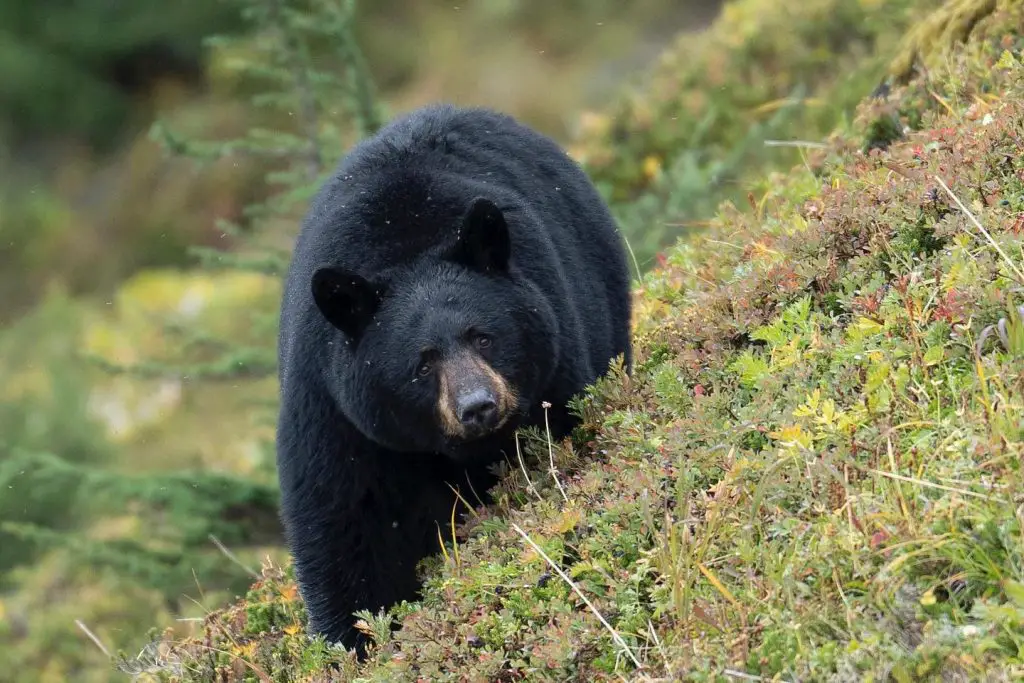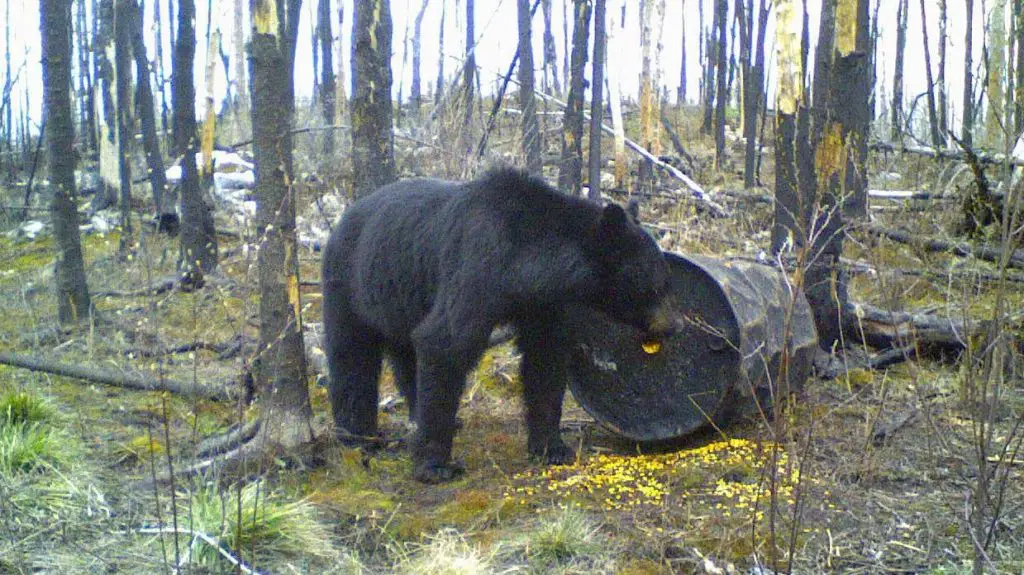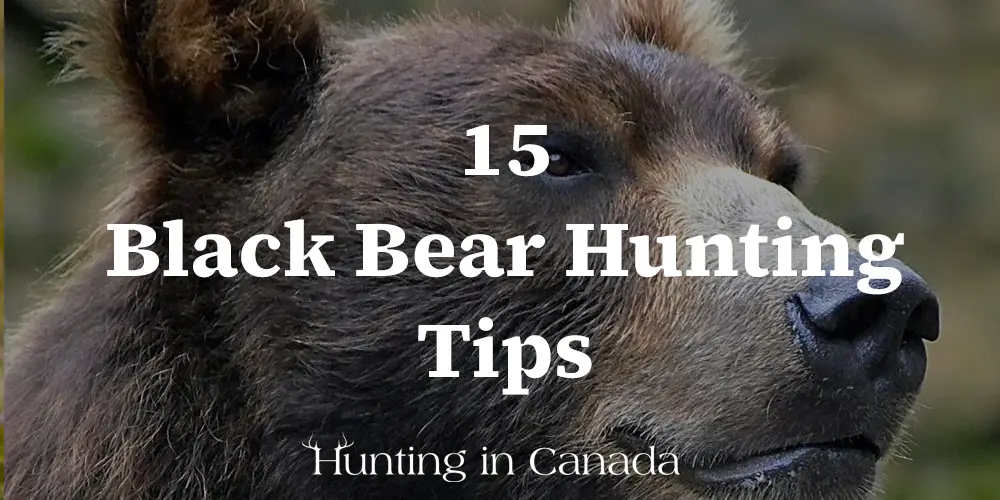Bear hunting is an intense and dangerous activity that requires advanced skills and safety awareness. There is something about hunting black bears that generates adrenaline in a hunter like no other big game. This is why many hunters take to the woods every year in hopes of shooting a black bear.
Whether you are using a rifle or bow, there are some important factors to consider in order to achieve a successful hunt, such as how to prepare for a hunt and avoid detection.
In this article, we will mention 15 black bear hunting tips that you can follow to have a great hunting experience and improve your odds of taking a bear.
Can You Hunt a Black Bear in Canada?
Hunting a black bear is available in Canada, for instance, in the Canadian provinces of Nova Scotia, Ontario, New Brunswick, Quebec, Manitoba, Saskatchewan, Alberta and British Columbia.
Black Bear Rut
The rut for bears differs from a whitetail or moose. Black bears breed in the spring, and late May to the end of June is a great time to take advantage of big, old boars roaming to find sows. At this time of the year, the big bears will put down their guard and show up where they normally wouldn’t.

Black Bear Hunting Tips
1. Watch Conditions, Not the Calendar, for the Start of the Season
Most bears spend the winter hibernating and come out from their dens in the spring. The bears may extend their hibernation period for a bit longer if their area is experiencing a particularly cold spring.
In the spring bear hunting season, the bears are not necessarily to be out once the season opens. In fact, later in the season usually offer the best hunting opportunity as more bears will emerge from their dens.
They will come out from their hiding spots when the weather is sunny and warm enough for grasses to green up. Green up will begin at lower elevations and move up as the season proceeds.
2. Scouting for Bears
Search for old timber and cutlines where green grass is coming up. Along these travel routes, check for hair on trees and brush. Take a close look to see if there are any trails and paw prints.
Look for any markers that indicate the bear’s presence. Bent over and marked-up trees, especially poplars, are considered good ones.
3. Cover Your Scent
Bears have a strong sense of smell. If they can smell you, they will not come anywhere near you. So you have to make sure that you stay downwind of the bear and that your hunting clothes have no scent on them.
For best results, you can wash the clothes you will wear to hunt with a scent-free laundry detergent. Make sure they are separated from any clothes that are washed with scented detergent.
4. Be Silent and Still
Black bears tend to be very skittish animals, and if you are not quiet, you can easily scare them off. Therefore, silence is a crucial thing when it comes to black bear hunting. You have to ensure that all your movements are in slow motion.
So wear clothing that does not make noise and avoid sudden movements. In order to increase your success rate of taking a bear, you have to reduce movements or noise that might alert a bear to your presence.
5. Choose Your Hunting Weapon
Bears are strong, powerful predators, so make sure to use a relatively powerful weapon for hunting. Some of these weapons include muzzle-loaders, rifles, and a bow and arrows if you prefer archery.
The most popular weapons for bear hunting are rifles since they can fire high-velocity bullets and kill a bear faster. Whatever weapon you choose, make sure to practice shooting with it before you go hunting. You have to be able to use it effectively.
6. Save the Midday Hours for Lunch and Napping
Whether you are hunting during the bear seasons or scouting prior to the season, the first and last hour of daylight is the best time of the day, as the bears will be the most active at this time.
The rest of the time, bears are likely to be searching for cover and shade. Although you can find bears throughout the day, they are very wary, and if they sense human activity, they will retreat to cover
It is easy for beginner hunters to feel they are doing something wrong and get discouraged, while the real reason may be that they target the most challenging time of the day to hunt in
7. Consider Calf and Fawns’ Distress Calls
Bears are harder to spot when they move from feeding in open meadows to forest cover. You can bring the bear to you by calling.
Bears can be very responsive to distress calls when elk and deer fawning seasons start. Search for a spot that has good elk and deer populations, then set up in a location from which you can see the bear when it comes.
You can attract bears with both mouth and digital calls. But when hunting predators, a lot of hunters prefer to work with digital calls as it is a safer option.
Setting up the digital call far from you will divert the focus of the bear from you to the call’s source.
8. Use a Tree Stand for a Safe and Effective Hunting Option
Set up the tree stand or the blind right from the beginning, so the bears are used to it. Make your choice whether you are a rifle hunter or a bowhunter, and set up to the appropriate distance.
The vantage point of a tree stand allows you to aim your shot without alerting the bear to your presence. Since you may have to wait there for several hours, it is important to ensure that your stand is as comfortable as possible.
For instance, if you want to move slightly in your stand without risking being seen, you can place some boarding around the stand covered in camouflage.
9. Pick the Kind of Bait You Will Use
The bears love many types of foods, so select which bait you are going to use. It is better to choose one that will not rot fast in the heat, which may attract flies.

10. Bear Baiting
Baiting is the most popular and effective method for hunting spring bruins. Choose an area that is likely to have good bear populations to place your bait.
When you place your bait location, choose a spot for your ground blind or tree stand first. Get your back to a pond, a creek, or a high ridge so it will be hard for a bear to circle around you to go close to the bait.
So instead of constantly trying to circle downwind and scent you before you even see them, they will keep coming from the thick cover in front of you.
When you choose a location, keep in your mind the predominant wind locations for the time of year you intend to hunt. For instance, August in some areas has more southwest and west. place the bait and the stand with the wind in your face and ridge or water on your back where the bears are not expected to approach.
11. Set up Your Bait
It is time to set up your bait. Some black bear hunters prefer using logs, rocks, or even barrels. Choose the way you want. Make or find a small depression and put the chosen bait in it, then cover it with big rocks, logs, etc.
This step has a lot of benefits, but for starters, it creates work for the bear to do and keeps it busy while you are preparing for your shot. This is also helpful to keep little critters from dragging the bait away before the bear gets to eat. Often the bear has to move around shuffling the rocks and logs, offering a clean shot to the hunter.
If you can not go to the bait site on a regular basis, stock it up for a prolonged period of time. Place a lot of bait out in order to create a food source that the bears begin to count on.
But if you have the ability to go there daily, then bait at the same time every day or do your best to do it at the same time as possible.
Always before 4 pm, never do this in the evening. as that is when you want the bears to feel comfortable and not be scared off for future hunting opportunities. You can set up a game camera in the location if you have one. Get your baiting routine down till you feel the right bear you are looking to harvest is coming in.
12. Stay Alert
Bears can move silently through the woods. So when they are coming towards your hunting area, you have better chances to see them rather than hear them. So using a good pair of binoculars or a spotting scope can be really helpful. You can use them to see any bear movement in the area, making you ready when a bear approaches.
13. Planning Your Shot
To know how to aim a good shot, you must know the build of the bears first. They are built differently than deer and other big game animals. When looking at a bear from the side, its chest is compressed compared to that of a deer.
If you do not make a good shot, a wounded animal can run for a long distance before it dies. Fat layers, hides, and heavy bones might prevent quick-clotting blood from dripping. In this way, you may not find a good trail to follow. So injured bears are hard to track.
Know your shot and know your capabilities. The most vital area of a bear is an 8 circle behind the front shoulder. So place your shot immediately in this area. This will kill the bear quickly as your shot will penetrate through the skin and into the vital organs.
But to kill a bear, one shot may not be enough. So if need be, be ready to fire a quick follow-up shot.
Since the skull of a bear is very dense, shooting the head is not recommended. The blunt, rounded shape can cause arrows or bullets to glance off or become lodged in the skull without penetrating.
14. Take Special Care of Your Bear
After harvest, you have to take care of your bear immediately. Similar to most other big game animals, you have to skin and cool down the bear as fast as you can.
But bears differ from elk and deer in that they carry a big amount of fat. So an additional step for you here is to remove all the fat you can from your bear.
Bear fat can spoil the surrounding meat as it is dense and holds lots of heat. If you take care of the bear meat properly in the field, it can make delicious table fare. But without proper care, it will probably taste greasy or rancid.
In order to skin the bear, lay the animal on its back and keep its legs and arms stretched out. After that, use a small knife to cut the animal from the pads of the paws to just below the neck.
Keep cutting from the neck along the abdomen to the tail, then make two other cuts along the rear legs. Cut around the feet and keep cutting the hide on the back of the bear.
Then try to cut as close to the skull of the bear as you can while cutting the hide away from the top of its body. This will ensure that the distinguishing facial features of the bear are able to be effectively preserved.
15. Take care of the hide
Then use the salt in order to dehydrate the hide and preserve it. Apply the salt liberally to the inside of the hide, on the lips, in the nose and ears, and between the feet.
You can use any kind of salt to preserve a hide. But most bear hunters prefer using fine-grained, non-iodized salt.
Use a burlap or game bag to pack the hide and carry it out of the woods. In order to fully dry out, hang the hide for about 5-7 days in an appropriate area ( out of the sun and dry). After that, take it to a taxidermist in order to be preserved. Notice that packing the hide in a plastic bag may rip the hair away from it.


